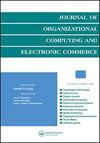From traditional interorganisational systems to cloud-based solutions: The impact on supply chain flexibility
IF 1.9
4区 管理学
Q3 COMPUTER SCIENCE, INFORMATION SYSTEMS
Journal of Organizational Computing and Electronic Commerce
Pub Date : 2018-10-02
DOI:10.1080/10919392.2018.1517480
引用次数: 9
Abstract
ABSTRACT The fast changing business environment and the intensive market competition forces firms to adjust and remodel their business strategy continuously. As a solution, firms seek flexibility, not only internally but also at the level of their supply chain. To accomplish this, companies invest in information technology (IT), aiming to improve their business processes and collaboration with trading partners. As previous research supports, the use of IT combined with agile supply chain management improves business performance and offers sustainable competitive advantage. However, the extent to which IT enables and supports supply chain flexibility is still debatable and warrants investigation. Although contemporary Internet-based systems (web-based platforms and cloud-based solutions) seem to overcome the rigidity and inflexibility of traditional interorganisational systems (IOS), they are still associated with issues of interoperability and incompatibility. Although they facilitate supply chain collaboration, by providing access to all stakeholders and enabling information-sharing, they may often lead to closed networks of collaboration. To examine these issues, this paper primarily aims to clarify the notion of flexibility at the level of the supply chain. It also aims to contribute to the process by which organisations effectively evaluate and prioritise competing IT investments. Taking into consideration the multidimensional nature of flexibility, this paper proposes a conceptual framework of supply chain flexibility, distinguishing between the operational, structural, and strategic levels of flexibility. It then uses this framework to explain the impact of IT infrastructures (specifically comprising traditional IOS, web-based collaboration platforms and cloud-based solutions) on the various levels of flexibility. Based on previous research, it identifies specific IT characteristics and provides an approach through which practitioners and researchers can compare different technologies and analyse their benefits and limitations, in terms of supply chain flexibility.从传统的跨组织系统到基于云的解决方案:对供应链灵活性的影响
瞬息万变的商业环境和激烈的市场竞争迫使企业不断调整和重塑经营战略。作为解决方案,企业不仅在内部,而且在供应链层面寻求灵活性。为了实现这一目标,公司投资于信息技术(IT),旨在改进其业务流程和与贸易伙伴的协作。正如先前的研究所支持的那样,将IT与敏捷供应链管理相结合可以提高业务绩效,并提供可持续的竞争优势。然而,IT在多大程度上支持供应链的灵活性仍然是有争议的,值得调查。尽管当代基于互联网的系统(基于网络的平台和基于云的解决方案)似乎克服了传统组织间系统(IOS)的刚性和不灵活性,但它们仍然与互操作性和不兼容性问题有关。虽然它们通过向所有利益相关者提供访问和实现信息共享来促进供应链协作,但它们通常可能导致封闭的协作网络。为了研究这些问题,本文主要旨在澄清供应链层面灵活性的概念。它还旨在促进组织有效评估和优先考虑竞争It投资的过程。考虑到灵活性的多维性,本文提出了供应链灵活性的概念框架,区分了灵活性的运营、结构和战略层面。然后,它使用这个框架来解释It基础设施(特别是包括传统的IOS,基于web的协作平台和基于云的解决方案)对不同级别灵活性的影响。基于先前的研究,它确定了具体的it特征,并提供了一种方法,通过这种方法,从业者和研究人员可以比较不同的技术,并分析它们在供应链灵活性方面的优势和局限性。
本文章由计算机程序翻译,如有差异,请以英文原文为准。
求助全文
约1分钟内获得全文
求助全文
来源期刊

Journal of Organizational Computing and Electronic Commerce
工程技术-计算机:跨学科应用
CiteScore
5.80
自引率
17.20%
发文量
7
审稿时长
>12 weeks
期刊介绍:
The aim of the Journal of Organizational Computing and Electronic Commerce (JOCEC) is to publish quality, fresh, and innovative work that will make a difference for future research and practice rather than focusing on well-established research areas.
JOCEC publishes original research that explores the relationships between computer/communication technology and the design, operations, and performance of organizations. This includes implications of the technologies for organizational structure and dynamics, technological advances to keep pace with changes of organizations and their environments, emerging technological possibilities for improving organizational performance, and the many facets of electronic business.
Theoretical, experimental, survey, and design science research are all welcome and might look at:
• E-commerce
• Collaborative commerce
• Interorganizational systems
• Enterprise systems
• Supply chain technologies
• Computer-supported cooperative work
• Computer-aided coordination
• Economics of organizational computing
• Technologies for organizational learning
• Behavioral aspects of organizational computing.
 求助内容:
求助内容: 应助结果提醒方式:
应助结果提醒方式:


